#FEDERALIZEUI LIKE CANADACOVID-19 Relief Funds Fuel Employer Tax Breaks
Instead of helping workers, states steer pandemic emergency dollars to employers to help them pay down unemployment insurance debt.
BY ELLA FANGER
DECEMBER 9, 2021
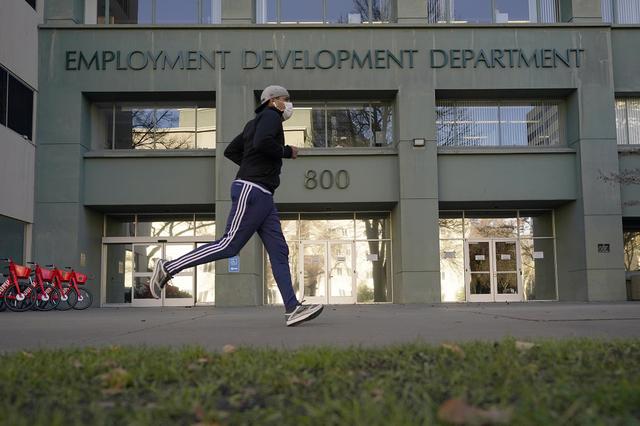
RICH PEDRONCELLI/AP PHOTO
A runner passes the office of the California Employment Development Department in Sacramento. California’s Chamber of Commerce has pressured the state to use federal relief funds to pay off unemployment insurance debt.
The $350 billion in federal fiscal relief to state and local governments in the American Rescue Plan (ARP) gave states an unprecedented opportunity to provide emergency housing, nutrition, health services, and other programs and benefits designed to help workers and communities deal with the pandemic’s economic shocks. But some states chose a different route—a tax break for employers at the expense of workers.
As unemployment rates spiked during the pandemic, states turned to federal loans to fund their unemployment insurance programs. Researchers at the Economic Policy Institute (EPI) have found that 16 states have used ARP funds to pay off these debts, after 23 states had already used CARES Act funds to bolster their unemployment insurance trust funds. Overall, 33 states from Texas to Connecticut have used federal COVID relief funds to pay off unemployment insurance trust fund debts.
More from Ella Fanger
When state revenues are insufficient to cover unemployment insurance demand, states can borrow from the federal Unemployment Trust Fund, but they must repay these debts within a few years. Historically, states have paid off these debts by increasing the state unemployment insurance tax rate on employers, so using COVID relief funds to pay off these debts effectively gives businesses a tax break.
“The spirit of this legislation was to be as broad as possible to really allow states to directly spend on people in a variety of ways,” says Asha Banerjee, an EPI economic analyst who worked on the findings. “This is not even direct aid to small businesses or something that businesses could use to invest in physical capital or hiring: This is just a future tax cut.” Banerjee also noted that some states with solvent trust funds instead cut benefits severely to avoid federal borrowing.
States have now spent a combined $15.7 billion of ARP funds that could have been used to make unemployment insurance more sustainable before the next crisis.
The unemployment insurance system was designed to be supported by state and federal taxes on employers. But in many states, these employer taxes are extremely low. In 2020, employers paid an average of just $267 per employee (down 4 percent from 2019), and 75 percent of employers paid no more than 50 cents for every $100 paid in employee wages.
The federal unemployment tax rate is 6 percent on the first $7,000 of wages per employee, but many employers do not even pay that full amount. Employers can get a tax cut of up to 5.4 percentage points, leaving them with a federal unemployment tax rate of just 0.6 percent. But employers cannot receive this tax cut if their state has outstanding debts to the federal government for their unemployment insurance programs, giving employers another incentive to push state officials to pay back these loans.
Chambers of commerce have been lobbying state governments to use COVID relief funds to pay off unemployment insurance debts. For instance, even after California pledged $1.1 billion of its federal relief funding package to pay off unemployment insurance loans, the California Chamber of Commerce pressured the state to use even more funds to pay off the entire debt. Business groups argue that unemployment taxes burden employers, especially small businesses, but the report’s authors pointed to the extremely low existing tax rates. “One could assume that money going towards unemployment insurance must be to the benefit of workers, but that unfortunately is not the case,” says Marokey Sawo, an EPI state economic analyst who also contributed to the research.
There are a number of other ways states could use these relief funds to help workers weather the pandemic. Firstly, states could use the funds to expand unemployment insurance benefits. (Some states did exactly the opposite earlier this year and returned federal unemployment benefits months before the end of the program in a misguided effort to force people to find jobs.) The federal unemployment expansion expired at the beginning of September, immediately cutting off benefits for 7.5 million people. Research from the Century Foundation and the University of Minnesota’s Aaron Sojourner estimates that 5.75 million workers whose benefits expired remain unemployed.
COVID relief funds also could be used to update antiquated state unemployment insurance administration operations. Many states rely on older computer systems and other outdated technologies that keep people waiting months for their benefits. These monies could be used to modernize and streamline unemployment application processes that are often complex and burdensome. Rehiring state government workers to fill the nearly one million jobs cut from state and local agencies would go a long way to help departments still trying to deal with unemployment application backlogs.
States have now spent a combined $15.7 billion of ARP funds to pay off unemployment insurance debts that could have been used to make unemployment insurance more sustainable before the next crisis and make substantial investments in social programs to help the most vulnerable workers. The researchers propose a number of alternative uses for the pandemic relief funds including improving access to broadband, education, housing, and workforce development. “This is a chance for states to really look at long-term investments,” Banerjee says, “But paying off unemployment insurance debt is not one of them.”
Gillibrand Slams ‘Four Men’ for Watering Down Military Sexual Assault Reform
The New York senator worked for a decade and assembled two-thirds of the Senate to support her reform, only to see it wither in a closed-door conference.
BY DAVID DAYEN
DECEMBER 8, 2021
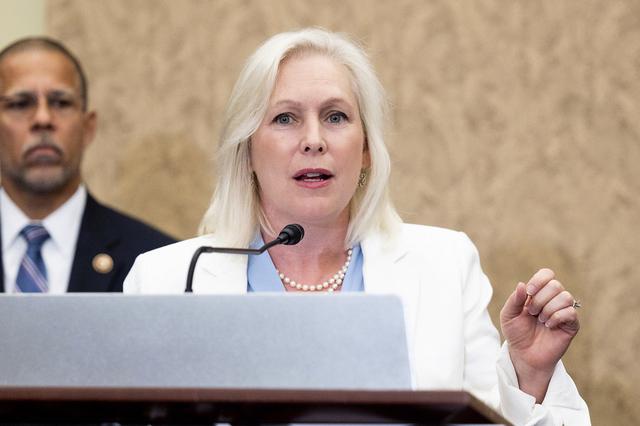
MICHAEL BROCHSTEIN/SIPA USA VIA AP IMAGES
Sen. Kirsten Gillibrand (D-NY) speaking at a press conference to introduce the Military Justice Improvement and Increasing Prevention Act, June 23, 2021
In a blistering statement, Sen. Kirsten Gillibrand (D-NY) excoriated leadership on the House and Senate Armed Services Committees for “doing a disservice to our service members and our democracy” by severely weakening a bipartisan military justice reform she spent nearly a decade cultivating.
The reform, which was folded into the annual defense policy bill, fails to take the prosecution of felonies out of the military chain of command, as two-thirds of the Senate and President Biden favor. Some press reports and activists have characterized the reform that made it into the bill as broader and more significant than expected, but there’s one critical sticking point. While it empowers an independent “Special Victim Prosecutor” for certain crimes—including sexual assault, rape, murder, and domestic violence—military commanders would still retain court martial convening authority on these cases. Commanders would also select jury members in court martial cases resulting from these crimes, approve witnesses, and manage the trials.
House Armed Services Committee leaders maintain that the special prosecutor’s charging decisions would still be “binding” and that commanders would face discipline if they didn’t follow those decisions. But Gillibrand and reform supporters doubt that special prosecutors would maintain that level of authority.
“Such influence erodes the independence of the Special Victims Prosecutor and fails to address the concerns of the survivor community that conflicted commanders still have too much influence over the military justice process,” said Col. Don Christensen, former chief prosecutor of the Air Force and president of the pro-reform group Protect Our Defenders, in an otherwise fairly positive statement.
Gillibrand characterized convening authority as critical to the process. Even the Defense Department’s Independent Review Commission (IRC) on Sexual Assault in the Military stated explicitly that any reform “that retained commanders as disposition authorities in sexual harassment, sexual assault, and related cases would fail to offer the change required to restore confidence in the system.”
The retention of convening authority by military commanders in the reform provision reflects a resistance to change, said Sen. Gillibrand.
The reform otherwise does enable victims to know what actions have been taken against their offenders, makes sexual harassment a crime under the Uniform Code of Military Justice (while excluding it from the special prosecutor framework), establishes independent investigations of sexual harassment complaints, and requires tracking of any retaliation against victims for coming forward. But it narrows the crimes eligible for special prosecution, something reformers anticipated.
The fate of the military justice reform has been uncertain for months. Gillibrand and her Republican co-sponsor, Sen. Joni Ernst (R-IA), were able to assemble 66 Senate votes for their version, a rare filibuster-proof majority in a divided Congress. But Sen. Jack Reed (D-RI), chair of the Senate Armed Services Committee and a close confidant of the Pentagon, fought to fold the bill into the National Defense Authorization Act (NDAA), to keep any changes within his committee and under his control.
In July, Reed placed the entire Gillibrand-Ernst Military Justice Improvement Act into the Senate version of the NDAA. But in an eerily prescient statement, a Gillibrand aide told the Prospect’s Amelia Pollard in June, “Our preference would be a stand-alone vote on the floor because that way it can’t get killed in conference, which seems apparent is their plan,” noting that “[i]t won’t come out of conference until … December, and then it’s bumping up against the holidays.”
That’s precisely what happened. The conference report reconciling the House and Senate versions of the NDAA, released on Tuesday, was the product of Reed, his Republican counterpart Sen. James Inhofe (R-OK), House Armed Services Committee chair Adam Smith (D-WA), and ranking member Mike Rogers (R-AL). These four men, as Gillibrand described them, overrode the desires of a supermajority in the Senate and at least a majority in the House.
In doing so, they ceded to a long tradition of delay from the Pentagon on these issues. As the Prospect reported last month, the Defense Department blocked a 2016 staff report that recommended fixes to the military’s sexual assault database, which was inaccurate and unable to track trends in real time. Five years later, there have been no improvements to the database. A Government Accountability Office report from February highlighted the failure to track cases.
The IRC report identified a number of failings in the military’s approach to sexual assault and harassment, and Defense Secretary Lloyd Austin laid out an implementation timeline in September. But some of the key elements are not scheduled to be completed until 2030, a fact that drew an angry letter from Gillibrand and her colleagues condemning the military’s “vague approach and lax timeline.” The New York Times reported that Austin called members of Congress to lobby against stronger reforms.
The retention of convening authority by military commanders in the reform provision reflects this resistance to change, Gillibrand says in her statement on the NDAA. “Committee leadership has ignored the will of a filibuster-proof majority in the Senate and a majority of the House in order to do the bidding of the Pentagon,” Gillibrand wrote.
While campaigning for president in April 2020, Joe Biden said he would “order the Defense Department to take urgent and aggressive action to make sure survivors are in fact supported and abusers are held accountable for their crimes.” The White House Statement of Administration Policy on the Senate version of the NDAA said that it “welcomes efforts by Congress to enact legislation that supports core aspects of the IRC’s recommendations for accountability.” There has been no statement from the White House on military commanders retaining convening authority.
Gillibrand said she would continue to seek an up-or-down vote on her version of the reform. The only amendment scheduled in the House concerned whether to include a bipartisan bill that would allow marijuana-based businesses access to banking services.

DAVID DAYEN is the Prospect’s executive editor. His work has appeared in The Intercept, The New Republic, HuffPost, The Washington Post, the Los Angeles Times, and more. His most recent book is ‘Monopolized: Life in the Age of Corporate Power.’
France’s Éric Zemmour Has Already Transformed America’s Far Right
The far-right pundit may not become the next president of France, but his ideas have influenced American nationalists for a decade.
BY MARTIN GELIN
DECEMBER 16, 2021
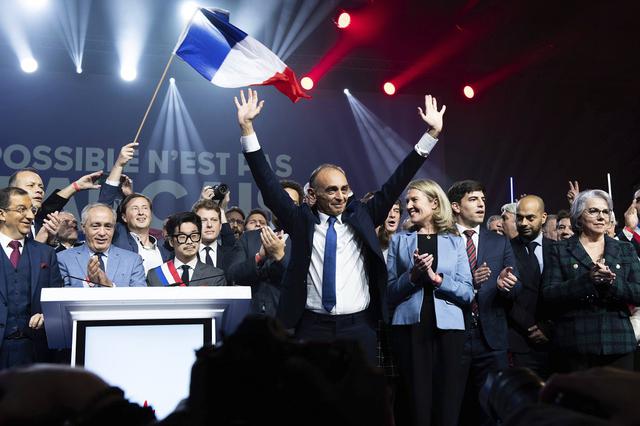
JEANNE ACCORSINI/SIPA VIA AP IMAGES
French far-right media pundit and 2022 presidential candidate Éric Zemmour delivers a speech at a campaign rally in Villepinte, near Paris, December 5, 2021.
French far-right pundit Éric Zemmour recently launched his presidential campaign with a rally that descended into brutal violence between his supporters and anti-racist protesters. Zemmour has become the star of French nationalism by courting controversy. In his books and TV commentaries, he has defended the Vichy regime, supported the death penalty, advocated for strict limits on immigration, and suggested that only “French” first names should be legal.
Unsurprisingly, Zemmour has been called a “French Tucker Carlson” by U.S. media. The two do have a lot in common. They are both influential nationalist pundits and fierce culture warriors. But it might be more accurate to see Tucker Carlson as an American Zemmour.
Long before Zemmour announced his run for president this fall, he was an influential voice among U.S. nationalists. His books and essays have been discussed on far-right websites, such as Counter-Currents, VDARE, and American Renaissance, over the past decade. His ideas have changed both the rhetoric and substance of nationalism in the U.S.
The “Great Replacement” theory was famously appropriated by the far-right activists of the Unite the Right rally in Charlottesville, in 2017.
In 2014, Zemmour published a book called Le Suicide français, which sold half a million copies in France in its first year, replacing Nobel Prize-winner Patrick Modiano on the domestic best-seller list. The book was not translated into English, but still received glowing reviews on several far-right websites in the U.S. Among the early adopters of Zemmourism in America were John Derbyshire (the disgraced journalist who was fired from the National Review in 2012 after publishing an article questioning the intelligence of Black people) and Paul Gottfried (a paleoconservative who coined the term “alternative right” for white nationalists in America). In articles for the far-right website VDARE, Gottfried and Derbyshire introduced Zemmour to America. Since then, Zemmour’s ideas have made a familiar journey from the fringe to the mainstream of American conservatism.
The title of Zemmour’s book refers to an alleged national suicide caused by progressive shifts in French culture and politics since 1968, particularly increased immigration and the cultural impact of feminism and gay rights. Along with far-right author Renaud Camus, Zemmour has popularized the phrase “Great Replacement” to drum up fears about immigration. For Zemmour, it describes what he considers a concerted attempt by Muslim immigrants to act as invaders bent on the conquest of France. It is no coincidence that Zemmour launched his own party called Reconquête (“reconquest”).
The “Great Replacement” theory was famously appropriated by the far-right activists of the Unite the Right rally in Charlottesville, Virginia, in 2017, and partly inspired the 2019 terrorist attacks on mosques in New Zealand. It’s also heard regularly on Tucker Carlson’s Fox News show, reaching millions nightly.
Zemmour’s consistent criticism of global capitalism has also been influential among American conservatives. He often talks about the need for corporations to be “patriots, not globalists,” and rails against the perceived progressive values of corporate boardrooms. These ideas have been a prominent feature of the French far right since the 1980s, when the so-called Nouvelle Droite and philosopher Alain de Benoist articulated an attack on what they perceived to be twin horrors of globalization: immigration and global capitalism.
In America, these ideas were initially popular with fringe paleoconservatives like Patrick Buchanan and Paul Gottfried, but now they are commonly heard among the ascendant “anti-globalist” wing of the Republican Party, led by Sen. Josh Hawley (R-MO), who recently published the book The Tyranny of Big Tech. From their point of view, big business is cynically and superficially linked with left-wing activism, based not on genuine conviction, but greed and self-interest. They believe that corporations have joined anti-racist and pro-immigrant campaigns because they want access to cheap labor, and that they share feminist and pro-LGBTQ messages because they hope to attract more consumers.
Zemmour’s cocktail of neo-reactionary ideas also consists of a radical attempt to rewrite history. He stridently defends the French Vichy government for protecting Jews during World War II, despite the fact that authoritarian, anti-Semitic Vichy rulers collaborated with the Nazis and shipped thousands of French Jews to Nazi death camps. The idea that any inconvenient truths should be banished from the official history of the nation has clearly permeated the thinking of American conservatives as well—see the frenzy over “critical race theory.”
The gradual rise of Zemmourism in America is symptomatic of the transatlantic currents of far-right ideas today, as digital platforms have lowered the threshold for the exchange of ideas across continents, leading to the rise of a nationalist international.
 |
| E V I L |
Zemmour’s cocktail of neo-reactionary ideas also consists of a radical attempt to rewrite history.
At the recent National Conservatism Conference in Orlando, Florida, one of the recurring themes was praise for Viktor Orban’s authoritarian nationalist government in Hungary. Rod Dreher, senior editor of The American Conservative, gave one of the keynote speeches, “What Conservatives Must Learn From Orban’s Hungary,” where he praised Orban’s attacks on liberal civil society, and bragged about convincing Tucker Carlson to travel to Budapest for a Fox News show on Orban’s anti-immigration policies.
Tellingly, Rod Dreher has had a revealing change of heart in his support of Zemmour. In 2019, Dreher posted a speech of Zemmour’s, translated by a reader of The American Conservative who wanted to be anonymous because of the belief that Zemmour is “extremely controversial.” Cautiously, Dreher introduced the speech by saying: “I am publishing the speech below not because I endorse it, but as an important political document for American readers to understand what’s happening in France now.”
Two years later, Dreher gave Zemmour full support; despite the fact that Zemmour has not tempered his extremism at all, Dreher now considers him a nationalist hero. When Zemmour launched his campaign in early December, Dreher wrote a glowing review, calling it “one of the greatest political speeches I have ever heard.” Not only did Dreher offer another translation of the speech, he also composed his own American remix of Zemmour’s manifesto, pleading that some Republican official take him up on the offer of using the same rhetoric in an American context.
Dreher is becoming a kind of ambassador of European-style authoritarian nationalism in the U.S. “We need to quit being satisfied with owning the libs and save our country. We need to unapologetically embrace the use of state power,” Dreher said in his speech in Orlando. In their vision, a strong state is the only institution powerful enough to reverse immigration and decades of progressive cultural shifts. Gone are the days when the leading conservatives, such as Grover Norquist, advocated for a government so small “we can drown it in a bathtub.”
At Zemmour’s launch rally outside of Paris in early December, Paul-Marie Coûteaux, a former member of the European Parliament who supported Marine Le Pen in the 2017 election, introduced the candidate by saying that Zemmour should be made the next “king of France.” In these authoritarian fantasies, the government is the only counterweight to the liberal institutions in civil society. From Tucker Carlson to Josh Hawley, this is now the ascendant belief on the American nationalist right.
Since the launch of Zemmour’s campaign, his support has fallen slightly. After hitting almost 20 percent in polls earlier this year, he now hovers around 13 percent. Zemmour may not be the future president of France. But the ideological cocktail he’s running on—“Great Replacement” fears, historical revisionism, screeds against woke capitalism—is possibly the future of nationalist conservatisms on both sides of the Atlantic.EUROPE
MARTIN GELIN is a journalist and author. His work has previously appeared in Foreign Policy, Boston Review, and The New York Times.
The Union of Autoworkers and Grad Students
With last week’s victory at the University of California, roughly 100,000 UAW members work for universities.
BY HAROLD MEYERSON
DECEMBER 16, 2021
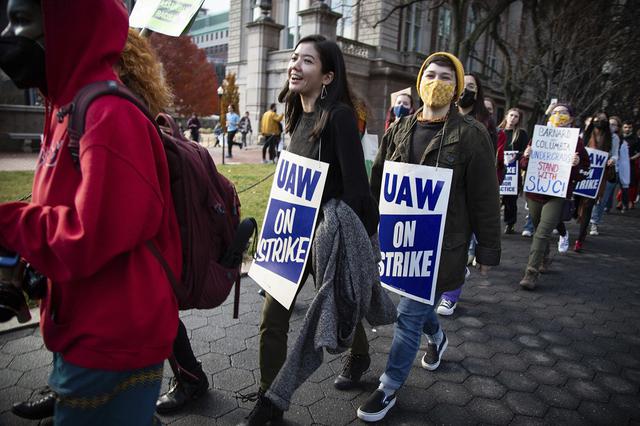
KARLA COTÉ/SIPA USA VIA AP IMAGES
Students and faculty members of Columbia University rallied on December 6, 2021, in support of striking university workers. A student worker union won recognition in 2016, but a first contract between the students and the university has yet to be ratified.
While the media’s labor buzz last week was all about the vote of two dozen Buffalo baristas to unionize the Starbucks where they worked, that was hardly the only big labor story of the week. (And let’s pause to acknowledge that any media buzz about workers winning some power has been all too rare over the past three or four decades.)
There was also the ongoing struggle of bakery workers to win a contract at Kellogg that wouldn’t consign new hires to diminished pay and benefits (Bernie Sanders is headed to Battle Creek on Friday to rally the troops). Running third in the media’s eye was actually the nation’s largest unionization in several years: 17,000 research assistants at the University of California have joined the United Auto Workers (UAW). Despite the relative lack of buzz, that unionization more immediately pointed to a brighter future for the American labor movement than the victory at Starbucks.
I say that because organizing workers in the private sector has proved nearly impossible in recent decades. The evisceration of the National Labor Relations Act (NLRA) at the hands of the courts, and the pathological hostility of owners and managers to the collective bargaining of their employees, have compelled workers seeking to join or form unions to risk their jobs in the process—a risk that usually stalls such efforts in their tracks. It may be, as my colleague Bob Kuttner suggested on Monday, that macchiato-drinking consumers will put pressure on Starbucks not to oppose further efforts by their baristas to unionize. Indeed, a unionization effort at two Starbucks locations in Massachusetts popped up this week. But the equation on how many unsold lattes it will take to prod Starbucks to do the right thing has not yet been solved.
UAW officials estimate that with last week’s victory at UC, roughly 100,000 of the union’s 400,000 members are university employees.
The NLRA, however, doesn’t cover public-sector workers, an omission that has proved greatly to those workers’ benefit, at least in blue states like California. Under Jerry Brown’s first go-round as governor in the 1970s, California public employees were given the right to unionize. It turned out that their employers—usually state or municipal elected officials—weren’t as eager as private-sector bosses were to affront workers who were also voters. That’s the short answer to why fewer than 7 percent of the nation’s private-sector employees are unionized today, while the level of unionization in the public sector exceeds 30 percent.
That’s also one reason why unions like the United Auto Workers, rooted in a private-sector industry, began organizing in the public sector, where growth remained possible. Like most such unions, the UAW began the process on its home turf, organizing workers employed by Michigan’s state government and then employees at the UAW’s de facto home campus, Wayne State in Detroit (home of the Walter Reuther archives and other UAW collections).
But that doesn’t fully explain how grad students whom universities employ as teaching and research assistants across the nation were drawn to the UAW. Part of the answer is the UAW’s affiliation, over the course of the 1980s, of the independent left union known as District 65—a trailblazer in the union movement for such causes as civil rights and anti–Vietnam War activism. Progressive activist grad students both in New York City (where District 65 was headquartered) and in Berkeley had long admired District 65, and the synergies between those students and District 65 organizers led to a growing UAW presence on campus.
It took some time for that presence to reach today’s scale. UAW officials estimate that with last week’s victory at UC, roughly 100,000 of the union’s 400,000 members are university employees. Most are at public universities in states where public-employee collective bargaining was established by liberal state governments. In addition to the University of California (all ten campuses) and the Cal State University system, UAW campus locals also function at the University of Massachusetts, the University of Washington, and a range of other colleges.
The UAW is hardly alone in representing universities. The two major teachers unions have locals at public universities across the country, as do a host of other unions, which, like the UAW, found growth more possible in the public sector than in the private. With fully one-fourth of its members working for universities, however, the UAW may well have the highest share of grad student members of any American union.
Winning recognition for those locals has been anything but swift or automatic. Even when a state government enacted collective-bargaining rights for public employees, it took a while, often decades, for those rights to trickle down to the grad students and postdocs who perform much of the teaching and research on campuses. When Republicans took control of California’s governorship following Jerry Brown’s first departure in 1982, the process stalled until Democrat Gray Davis won in 1998, whereupon UC teaching assistants gained the right to unionize. Efforts to unionize UC research assistants then were put on hold during the governorship of Republican Arnold Schwarzenegger, but when Jerry Brown returned to office, the RAs won that right, abetted by a new system that enabled them to seek recognition when a majority of them had signed affiliation cards.
There are some ploys that non-university employers use to defeat unionization that won’t work with grad students.
Even so, UC President Michael Drake, in the dismal tradition of most American employers, withheld recognition until 97.5 percent of those signatories voted in late November to strike if not recognized. In addition, 30 Democratic members of Congress from California, led by Katie Porter of Irvine, sent a letter to Drake urging recognition. At that point, Drake caved, and the American union movement racked up its largest successful unionization campaign of the year.
The UAW not only represents employees at public universities, but also at a handful of prominent private universities, chiefly Harvard, Columbia, and NYU. For many years, the most venturesome and progressive region of the UAW (preceding even the District 65 affiliation) has been Region 9A, which covers New York and New England, and which began organizing private and public campuses many years ago. To win the right to organize grad student employees at private universities, however, required a ruling from the National Labor Relations Board (NLRB) that those students, when acting as TAs and RAs, were actually employees who were covered by the NLRA.
The students won such a ruling under the Clinton NLRB, saw it revoked by the Bush NLRB, reinstated by the Obama NLRB, hindered by the Trump NLRB, and are in the process of having it reconfirmed under the Biden NLRB. Their efforts have been fiercely opposed by university administrations, particularly at Columbia, where students won recognition in 2016, but where the administration has been so slow to negotiate that a first contract between the students and Columbia has yet to be ratified. (That’s one reason why grad students there are currently on strike, as my colleague Alex Sammon wrote about on Tuesday.)
There are some ploys that non-university employers use to defeat unionization that won’t work with grad students. First, while Amazon may be able to convince its workers that they’ll lose their jobs if they vote for a union, that’s a little harder to do at, say, Harvard, where the thousands of teaching and research assistants aren’t easily replaceable. Second, the latest Gallup poll showed that fully 77 percent of people aged 18-34, the cohort encompassing the age range of grad student workers, have a favorable view of unions. These combined factors create significant momentum for unionizing. One clear illustration of why grad students are so anomalous among private-sector workers is that when the Columbia grad students won their NLRB-run election in 2016, and when their Harvard counterparts won theirs in 2018, those were the largest NLRB election victories for any union in those respective years.
Last week’s addition of the RAs to the ranks of unionized UC grad students and postdocs means that total UAW membership at the nation’s most prestigious public university system now totals between 43,000 and 44,000, by the UAW’s estimate. That makes the University of California the fourth-largest employer of UAW members, exceeded only by General Motors, Ford, and Chrysler (which is now part of a company named Stellantis).
By sheer coincidence, last week’s victory coincided with a vote by UAW members to shift the way they elect their national officers, moving from a quadrennial convention of delegates elected by their locals to a rank-and-file vote of all individual members. In this, the UAW is following the Teamsters, and for the same reason: At the end of the 1980s, federal prosecutors put the Teamsters under federal trusteeship to cleanse the union of its pervasive corruption, and one element of that trusteeship required moving to rank-and-file elections. The trusteeship has since been lifted, but the Teamsters have opted to keep the elections.
The UAW’s 100,000 university employees, chiefly grad students, will have considerable influence over the course of what once was America’s greatest union.
In recent years, the UAW has seen a precipitous decline not just in size, as auto production has been outsourced to foreign lands and the non-union South, but also in the quality and honesty of its leaders. Federal prosecutors have won convictions against a host of high-ranking UAW officials, including two former presidents, for spending union funds on their own luxurious lifestyles. This year, the feds required the union to hold a vote of its members to see if they wished to switch to rank-and-file elections rather than delegated conventions, where some of the voting had been manipulated by self-seeking officials. In November, members voted overwhelmingly to make that switch.
That means the UAW’s 100,000 university employees, chiefly grad students, will have considerable influence over the course of what once was America’s greatest union. Roughly 160,000 UAW members now work at the Big Three auto assembly companies, and a smaller number work for parts plants and other links in the firms’ supply chains.
Over the course of the seven rank-and-file elections the Teamsters have held, turnout has seldom exceeded a quarter of the membership; it’s usually far lower. My hunch is that the turnout rate of the UAW’s autoworkers will exceed that of the Teamsters, but will likely lag behind that of the UAW’s university employees. There will be a clear generation gap: The median wage of unionized autoworkers hovers around 50, while the median age of grad students, even factoring in those who take forever to finish their dissertations, is at least two decades lower. Moreover, a higher percentage of grad students are women, and perhaps people of color, than is the case among autoworkers.
“I’m excited not just about welcoming new members from higher ed to the union,” Cindy Estrada, the UAW vice president for its university units, told the Prospect, “but also for the diversity of voices that will bring to the dialogue within the union.”
The UAW executive board consists of the president, secretary-treasurer, and several vice presidents, along with the leaders of the union’s roughly dozen regions, who will also now be elected by the rank-and-file members. At this point, the UAW’s westernmost region is numerically dominated by the grad students in California and Washington, which all but ensures more of the “diversity” that Estrada spoke of.
Perhaps this is all more fitting than it may at first seem. It was the UAW, after all, that lent its Port Huron campus to a group of student leftists in 1962, where they formed Students for a Democratic Society and drafted the Port Huron Statement. And while the UAW was slow to embrace the Vietnam anti-war movement (in 1967, Reuther backed the ineffectual halfway house of Negotiations Now), in the 1970s, particularly under the leadership of Reuther successor Doug Fraser, the union worked to rebuild a broad, transgenerational left.
Region 9A had embraced that position earlier, as I can personally attest. When I was an undergraduate at Columbia in 1970, I was part of a student group that was meeting in some dingy Morningside Heights basement to plan our participation in an upcoming massive anti-war demonstration. There was a knock on the door, and in walked someone we didn’t know, who didn’t appear to be one of us, as he looked to be in his forties. “I’m from the UAW,” he said. “What can we do to help?”
The intruder, who was to provide all kinds of major logistical help, was Ed Gray, then the deputy director (and later director) of Region 9A. Ed was one of the many Reutherite leaders who saw his mission as building a more social democratic America, which at the time required not just ending the Vietnam War, but building bridges between the Old Left and the New, between workers and students.
Half a century later, the UAW is back on campus—this time in force.

HAROLD MEYERSON is editor at large of The American Prospect.
Will Starbucks Bargain With Its Baristas, or Just Pretend To?
Many newly unionized employers go discreetly AWOL (or worse) when it comes to negotiating a first contract. Coffee drinkers shouldn’t let Starbucks get away with that.
BY TERRI GERSTEIN
DECEMBER 16, 2021
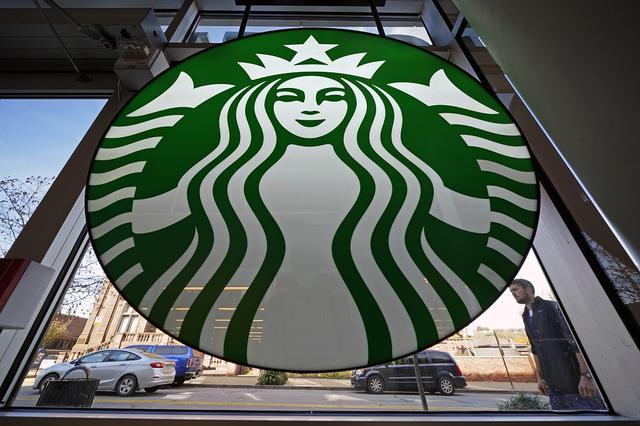
GENE J. PUSKAR/AP PHOTO
Employers can stymie workers’ rights by refusing to negotiate with the union, or by just going through the motions.
The victory of the Buffalo Starbucks baristas last week in their vote to join a union offers concrete proof that workers can win, and that even a Fortune 500 corporation—one of the nation’s wealthiest—is not unbeatable. While there are still questions about what the union’s win means for the labor movement nationally, it’s clear that the campaign is already catalyzing worker organizing in other cities across the nation, from Boston to Arizona.
But even in Buffalo, the battle is far from over. Thursday’s union victory marked perhaps the end of the beginning. Serious challenges remain, including bargaining a first contract. Unfortunately, there are too many ways employers can try to destroy a union even after an election. We need better laws to stop these subtler forms of thwarting workers’ collective will. And until that happens, we need continued and focused public pressure on Starbucks to seriously negotiate with the people who make and pour the coffee.
More from Terri Gerstein
What can employers do post-election? They’re permitted to mount certain challenges to the election itself, and some abuse this process. Worse still, some employers make brazenly illegal moves, like retaliatory closures of locations or firings of union activists.
Employers can also stymie workers’ rights by refusing to negotiate with the union, or by just going through the motions. The goal of unionizing is to improve working conditions, which happens by the union reaching a binding contract with the company covering wages, benefits, and other working conditions. And a contract at one Buffalo store could ultimately be far-reaching, potentially serving as a master contract replicated at other Starbucks locations.
More than half of all workers who vote for a union still don’t have a contract a year later; 37 percent of new private-sector unions don’t have a contract two years after an election.
Once a union has won an election, the company is required to bargain “in good faith.” But that requirement doesn’t have real teeth. If a company refuses to bargain, the National Labor Relations Board typically issues an order commanding the company to, well, bargain.
In fact, a company can give the appearance of good-faith bargaining while avoiding any real progress: giving the union skimpy, unserious counteroffers, or slow-walking the exchange of relevant documents—all without completely stonewalling. If, in the process, workers go on strike because they want better working conditions, federal law considers them “economic strikers” and allows the company to permanently replace them. (The cereal-maker Kellogg recently announced its intention to replace 1,400 strikers, a stance that President Biden condemned. Canadian law, by contrast, doesn’t allow this.) Strangely, there’s no mechanism for the NLRB or anyone to ensure that an actual union contract is ever reached.
Such foot-dragging moves enable some corporations to delay reaching the first union contract for years. More than half of all workers who vote for a union still don’t have a contract a year later; 37 percent of new private-sector unions don’t have a contract two years after an election. A 2021 analysis by Bloomberg Law found that the average time period for new union locals and employers to sign an initial agreement is 409 days.
Obviously, negotiating a contract doesn’t happen overnight. But stalling tactics and a lack of progress in bargaining can dissuade workers from unionizing, by conveying the sense that it’s futile even if you win the recognition election. Delay and surface bargaining can deflate the union’s momentum. And the law allows workers to petition to decertify the union one year after the union is certified. Employers can thereby delay real bargaining in the hope of making the union seem ineffectual, all the while drumming up anti-union sentiment and laying the groundwork for a rerun of their anti-union campaign.
The baristas at Starbucks could face this kind of campaign. The problems that unions encounter in this phase of their dealings with the employer—heel-dragging in negotiations and surface bargaining about window-dressing issues—are more nuanced and complex than those they battle pre-election. “Union-busting is disgusting” fits nicely on a union placard, but how would you succinctly sloganize the harm from disingenuous surface bargaining or slow-walking the sharing of key information? It’s a subtler, passive-aggressive version of union opposition, but it’s hard to explain to the public, and hard to address under current law.
A proposal in Congress, the Protecting the Right to Organize Act of 2021 (the PRO Act), would help with this situation: In addition to prohibiting permanent replacements for striking workers, the bill contains a procedure to ensure a first contract is reached relatively promptly, through referral of disputes to a three-person panel with power ultimately to impose contract terms.
But until the PRO Act passes, which currently seems unlikely given the Senate’s filibuster-driven requirement for 60 votes, public pressure is a critical tool to help persuade a company to engage in good-faith bargaining. Workers need the media to continue its focus on the Starbucks campaign, even though the drama of the election has passed. Elected leaders, members of the clergy, celebrities, and ordinary coffee consumers will need to communicate to Starbucks their strong support for the union, as well as the expectation that the company will respect the vote and end its anti-union campaign, in Buffalo and wherever baristas seek to organize. The public can urge Starbucks to negotiate immediately in good faith, and to make proposals that are substantive and responsive to workers’ concerns.
The Starbucks workers want their company to flourish. They just want a voice on the job, and better working conditions. Starbucks should sit down at the table, share a cup of joe, and quickly get to work on reaching a contract. And coffee drinkers everywhere should let Starbucks know that’s exactly what they expect.
The Path to Unionization of Starbucks
Today on TAP: Why this image-conscious company is more vulnerable than your typical fast-food joint
BY ROBERT KUTTNER
DECEMBER 13, 2021
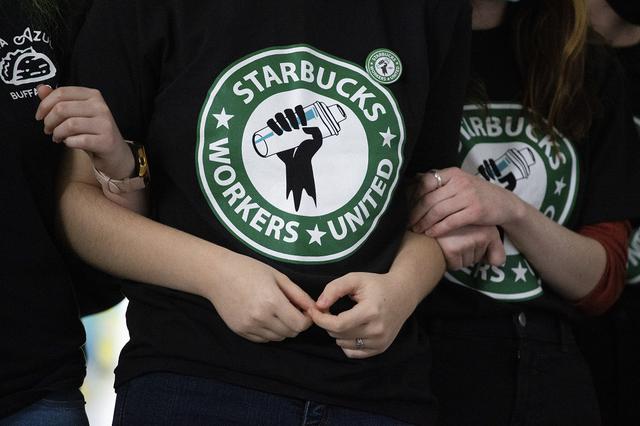
JOSHUA BESSEX/AP PHOTO
Starbucks has to worry about reputational damage if it becomes known as a union-buster.
As you’ve heard, a Starbucks in Buffalo won union certification from the NLRB last Thursday. On Friday, my colleague and dear friend Harold Meyerson threw some cold coffee on the victory, pointing out that this is just one Starbucks unit out of more than 15,000, and that union successes in small fast-food places are close to nil.
It pains me to disagree with Harold, who is a source of great insight on all things labor, but I think he is being unduly and uncharacteristically pessimistic in his analysis. I will bet Harold a double caramel macchiato at the Starbucks of his choice that at least 100 Starbucks are unionized by this time next year.
The reason is that Starbucks is not your typical fast-food operation. For starters, unlike most of the industry, Starbucks stores are not franchises. They are owned and operated by the Starbucks Corporation.
For another, Starbucks is not just selling coffee; it is selling an image and an experience—of a cool, socially benign company, one that features hip baristas and pays attention to humane details like fair-traded coffee and the workers who grow it.
In short, Starbucks has to worry about what they call reputational damage if it becomes known as a union-buster. It is thus a sitting duck for customer pressure.
To be specific, consumers could threaten a boycott unless Starbucks agreed to stay scrupulously neutral in unionization drives elsewhere, as other Starbucks workers seek to emulate their sisters and brothers in Buffalo. Sign the pledge, or we start buying our coffee at Dunkin’ Donuts, where the stuff is cheaper, less pretentious, and just as drinkable.
Starbucks did resort to the usual union-avoidance tactics in Buffalo. But Starbucks looks like hell if it persists with union-busting as this drive turns into a national movement.
Readers may recall the successful campaign of the tomato workers in Immokalee, Florida. They were able to get raises because consumers put pressure on the fast-food chains that purchased the tomatoes, beginning with Taco Bell.
If Taco Bell was vulnerable, Starbucks is doubly vulnerable. I hope Harold gets properly caffeinated and keeps reporting on this story as unionization gains ground(s).

ROBERT KUTTNER is co-founder and co-editor of The American Prospect, and professor at Brandeis University’s Heller School.
Just How Exceptional Are the Buffalo Baristas?
They’ve unionized one Starbucks. They symbolize a fed-up proletariat. But does their victory portend anything further?
BY HAROLD MEYERSON
DECEMBER 10, 2021
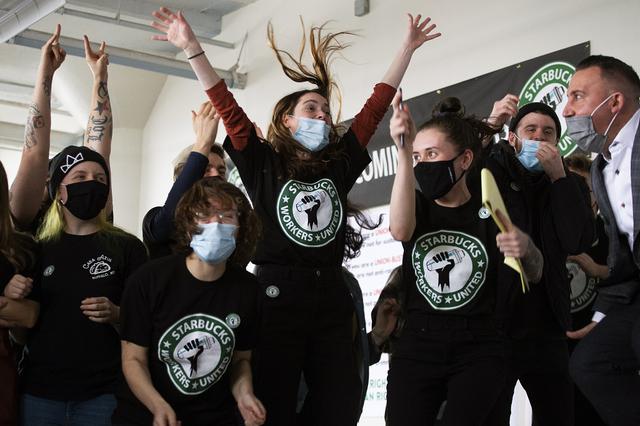
JOSHUA BESSEX/AP PHOTO
Starbucks employees and supporters react as votes are read during a watch party of their union election, December 9, 2021, in Buffalo, New York.
By a vote of 19-8, baristas at one Buffalo Starbucks have voted to join a union, according to a vote count tallied Thursday by the National Labor Relations Board. Baristas at another Buffalo Starbucks voted against joining, while baristas at a third may have voted to join, though some of the ballots are being contested.
Given the steep tilt toward management that our dysfunctional labor law permits, and the opposition that the Starbucks empire inflicted on their workers, the victory at even one of the company’s 15,000-some U.S. outlets is remarkable.
It’s also very, very small.
The union with which the baristas affiliated is Workers United, a rather small branch of the two-million-member Service Employees International Union. Nearly a decade ago, SEIU kicked off a trailblazing campaign to raise hourly wages in the fast-food industry to a then unheard-of $15, and to win those workers a union. The first half of its campaign succeeded beyond all expectations. In a number of left-leaning cities and states, the minimum wage, not just for fast-food workers but all workers, has been raised to $15, most impactfully in California and New York state.
The second half of SEIU’s campaign—winning those workers a union—until yesterday had gone absolutely nowhere. States and municipalities, no matter how progressive, have no jurisdiction over the rules of unionization, which are set by the federal National Labor Relations Act. Decades of anti-union court rulings and the deep hostility of employers to giving their employees a voice in the workplace—including supposedly worker-friendly employers like Starbucks—have so weakened the NLRA that unionization has proven effectively impossible.
I suppose if we reclassify Starbucks as a fast-food purveyor, SEIU can now claim to have unionized one such outlet, which, if a contract is agreed upon, will produce dues totaling 1 percent of 1 percent of 1 percent (continue indefinitely) of SEIU’s income. By that metric, it’s not much to show for the many millions of dollars the union has spent over the years on its “$15 and a Union” campaign. By the metric of changing some millions of lives for the better due to hikes in the minimum wage, however, SEIU’s performance has been nothing less than heroic.
Only the largest unions can afford such uncompensated heroism, however. This is something that the Teamsters, which has pledged to unionize Amazon, and will soon be under new leadership that vows to go all-in on that campaign, must ponder. The illegal tactics that Amazon employed earlier this year to squelch a unionization campaign at its warehouse in Bessemer, Alabama, illustrate the lengths to which it will go to keep its employees powerless. In that case, Amazon’s conduct was so egregious that the NLRB ordered it to hold a new election.
The union waging this particular campaign isn’t the Teamsters, but rather the Retail, Wholesale and Department Store Union, and it’s not at all apparent that the RWDSU is going about this in the right way. For one thing, Amazon offers some of the highest-paying jobs available to non-college-educated workers in Alabama, which, in addition to the pressures the company put on its employees to reject the union, was one reason why they voted the union down by a 71 percent to 29 percent margin earlier this year.
Herein lies a broader problem. Because work in Amazon warehouses is so fatiguingly fast-paced and the injury rate so much higher than the industry norm, the company has compelled itself to outbid its competitors in the scramble for workers. As of September, the average starting wage at an Amazon warehouse, the company said, was $18.32 an hour. That may not go very far at its Staten Island warehouse, but it’s a lot higher than the average pay for non–college grads in Alabama, and in most of the non-metro-area locales where Amazon locates its warehouses.
To be sure, discontent at the impossible pace Amazon warehouse workers are forced to keep, and the constant surveillance they’re under, is such that the yearly turnover rate averages more than 100 percent. But discontent only helps prompt unionization when the workers remain on the job. When the workforce consists of relatively highly paid newbies already looking for the exits, organizing, the most arduous of tasks in the best of circumstances, becomes more arduous still.
By the metric of changing some millions of lives for the better due to hikes in the minimum wage, SEIU’s performance has been nothing less than heroic.
Randy Korgan, the Teamster whom the union has tasked with heading up its campaign, acknowledges that mobilizing not just the rank and file but also every conceivable community and political ally will be integral to its efforts. It will require such bank shots as the complaint just filed with the Federal Trade Commission against Amazon over its practice of failing to label which listings on its site are paid for by advertisers as consumers search for a product. The complaint was lodged by the Strategic Organizing Center, which is chiefly funded by the Teamsters and SEIU. By extension, we might see the Teamsters building a campaign around Sen. Elizabeth Warren’s proposal to break up the company on antitrust grounds.
Even despite the myriad obstacles with which employers and the courts have sought to deter any growth in worker power, workers’ desire for such power continues to rise. In each of the past three months, the share of workers quitting their jobs is higher than any since the government began recording quit rates. (In a workforce that’s just 11 percent unionized, quitting is the option available to the other 89 percent.) The approval rating of unions, at 65 percent, is the highest it’s been in the past 50 years. The Buffalo baristas are not alone, and this broad demand for a voice at work is a factor that the Teamsters will be trying to figure out how to operationalize as they commence their campaign.
This demand has taken a range of forms in recent weeks. It was apparent in the strike of 10,000 workers against John Deere, who rejected two Deere proposals that their own United Auto Workers officials recommended before finally accepting a third, and better, offer. It was apparent this past weekend when the 1,400 members of the Bakers Union (the BCTGM, for you acronym lovers) on strike against the breakfast cereal titan Kellogg also rejected a contract offer that some of their leaders had recommended.
Earlier this year, the BCTGM had won better pay and conditions in strikes against Frito-Lay and Nabisco. Kellogg, which has long demonstrated more hostility to worker organization than its Big Bakery competitors, has continued down that path in the course of the current strike. At issue, and it’s been an issue in most of the year’s other strikes, is the employer’s wish to maintain (or in Kellogg’s case, make even worse) its two-tier employment system, under which newer hires must wait years to become eligible for full pay and benefits.
At first, Kellogg proposed to change the system so that new hires would never become eligible for more senior pay and benefits. In its subsequent offer to the union, it proposed making 3 percent of those newer hires eligible for moving to the senior tier each year—at which rate, members at Kellogg’s Omaha plant (its largest in the U.S.) calculated, it would take new hires an average of nine years on the job to become eligible for full pay and benefits. Worse yet, Dan Osborn, the president of BCTGM’s Omaha local, told me yesterday, “those nine years would not count toward your pension.” Upon news of the union members’ overwhelming rejection of the proposal, Kellogg vowed to permanently hire replacements. With unemployment in Nebraska at just 1.9 percent, however, and with the jobs requiring both long hours and extensive training, Osborn doubted how seriously Kellogg was taking its own threat. “Permanent replacements?” he said. “Who the hell with?”
Of the 470 members of the Omaha local, Osborn estimates, just a dozen have crossed the picket lines to return to work.
Decades of anti-union court rulings and the deep hostility of employers to giving their employees a voice in the workplace have so weakened the NLRA that unionization has proven effectively impossible.
Worker militancy, even in the face of their leaders’ recommendations, has also been in evidence recently in the vote of UAW members to change the way their leaders are selected. Since its founding in 1936, the UAW has chosen its leaders at conventions of delegates elected by its member locals, the method that nearly every American union employs. In the 1940s, that led to a caucus headed by Walter Reuther taking power. For decades, this leadership produced the best contracts, the most assistance to social justice movements, and the most serious challenges to management control of any union in American history.
It also preserved the caucus structure, even though any serious opposition to it had ceased to exist by the early 1950s. In recent decades, as the union’s social democratic leaders departed the scene and the caucus structure ossified, it began producing a wholly different breed of leaders. In the past few years, two UAW presidents and a host of lesser officials have pleaded guilty to raiding the union’s treasury to fund elaborate lifestyles, offenses that would have appalled Reuther, who was not only a dedicated socialist but also a thoroughgoing puritan.
This fall, the federal prosecutor who put those two presidents behind bars ordered the union to let its members vote on whether they wished to continue to select their leaders in delegated conventions, which in recent decades had been dominated by the self-dealings of many of those leaders, or preferred to change to rank-and-file elections. (Omitted from the choices was the union’s 1938 convention process, in which, by the decree of the new union’s somewhat unstable president, Homer Martin, delegates’ preferences were to be recorded by newfangled sound-o-meters, which would determine which candidates had the most support by comparing how much noise their supporters made when asked to vote. After the delegates had all but destroyed the convention hall in the course of making the loudest noise possible, that system was discarded.)
Anyway, this fall, the members opted for rank-and-file voting. It’s the same method the Teamsters use, and for the same reason: A quarter-century ago, federal prosecutors required the Teamsters to use it as part of cleaning up the union, and the Teamsters have stayed with it, even though the federal monitorship has been lifted.
There’s nothing inherently transforming about rank-and-file voting. Since its adoption, the Teamsters have elected as their president an outsider-reformer (Ron Carey) for one term, then the more establishment James P. Hoffa (son of the legendary Jimmy) for four terms, and this fall, an insider with reformer support (Sean O’Brien). The share of members actually voting has never exceeded one-fourth of the membership and is usually a good deal lower.
But after enduring a string of presidents and other officials who ended up in jail for misappropriating the dues they paid, the UAW rank and file opted to take more direct control of who speaks and negotiates for them. They displayed a form of the same desire for more control over their working lives that we’ve seen this year at Kellogg, Nabisco, Frito-Lay, and John Deere; among the behind-the-camera workers in Hollywood and the nurses at Kaiser Permanente; and now among the baristas at a Buffalo Starbucks. That desire can surely be found among the million-plus workers at Amazon, and millions of American workers elsewhere, though the Teamsters, and the union movement, and American progressives are all still a very long way from discovering how to turn that desire into tangible gains.
The Myth of Artificial Intelligence
‘The Age of AI’ advances a larger political and corporate agenda.
BY MEREDITH WHITTAKER, LUCY SUCHMAN
DECEMBER 8, 2021

DEPARTMENT OF DEFENSE
A Marine Corps unmanned aerial system, used as an intelligence-gathering asset
This article appears in the November/December 2021 issue of The American Prospect magazine.
The Age of AI: And Our Human Future
By Henry A. Kissinger, Eric Schmidt, and Daniel Huttenlocher
Little, Brown
The term “artificial intelligence” is widely recognized by researchers as less a technically precise descriptor than an aspirational project that comprises a growing collection of data-centric technologies. The recent AI trend kicked off around 2010, when a combination of increased computing power and massive troves of web data reanimated interest in decades-old techniques. It wasn’t the algorithms that were new as much as the concentrated resources and the surveillance business models capable of collecting, storing, and processing previously unfathomable amounts of data.
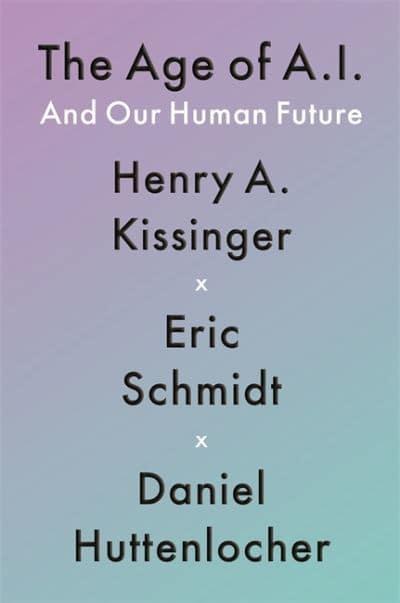
In other words, so-called “advances” in AI celebrated over the last decade are primarily the product of significantly concentrated data and computing resources that reside in the hands of a few large tech corporations like Amazon, Facebook, and Google. At the same time, AI technologies are increasingly shown to be brittle, systemically biased, and applied in ways that exacerbate racialized inequality.
The Age of AI works to take the debate about artificial intelligence off the table by obscuring the relevant technologies and the political economy behind them. Its title alone—The Age of AI: And Our Human Future—declares an epoch and aspires to speak on behalf of everyone. It presents AI as an entity, as superhuman, and as inevitable—while erasing a history of scholarship and critique of AI technologies that demonstrates their limits and inherent risks, the irreducible labor required to sustain them, and the financial incentives of tech companies that produce and profit from them.
While the book’s intellectual contribution is marginal, the political agenda of its authors merits careful consideration.
Henry Kissinger needs no introduction. Even at 98 years old, he remains an influential voice in foreign policy despite his sustained commitment to U.S. exceptionalism, military dominance, and entrenching the military-industrial complex.
The public is recognizing that it has a choice in whether AI is developed and widely adopted.
Eric Schmidt is the former chief executive of Google and former executive chairman of its parent company Alphabet. He has worked over the last decade to encourage investments by the military and intelligence establishments in Big Tech infrastructures and to market their products, including Google’s AI technologies, as indispensable to U.S. military prowess. He’s also a billionaire and a philanthropist, whose Schmidt Futures underwrites positions throughout the federal government, and many tech-related civil society organizations and initiatives. Over the last several years, he chaired the National Security Commission on Artificial Intelligence (NSCAI), an advisory board to Congress and the Pentagon comprising Big Tech executives, military and intelligence professionals, and academic elites.
Daniel Huttenlocher is the dean of MIT’s Schwarzman College of Computing, an AI-focused mega-lab that was launched thanks to a $350 million gift from foreclosure profiteer and longtime Trump supporter Stephen Schwarzman, the co-founder of the investment group Blackstone. Huttenlocher is also board chair of the MacArthur Foundation, which funds progressive nonprofits and initiatives focused on tech accountability.
This book provides Eric Schmidt and his co-authors a new occasion for a well-funded PR campaign, during which they will be given opportunities to present their views to large audiences, and likely to brief policymakers and other political actors.
In this way, The Age of AI should be understood as a companion to the work that the NSCAI has already done under Schmidt’s leadership. In March, the NSCAI issued a report that echoed Cold War rhetoric to recommend $40 billion in federal investments in AI, warning that the U.S. must maintain AI supremacy or risk being eclipsed by China. The NSCAI report and The Age of AI serve Big Tech’s agenda through three rhetorical strategies.
First, they position Big Tech’s AI and computing power as critical national infrastructure, across research and development environments, and military and government operations. Second, they propose “solutions” that serve to vastly enrich tech companies, helping them to meet their profit and growth projections, while also funding AI-focused research programs at top-tier universities. This serves to bring Big Tech and academia closer together, further merging their interests and deterring meaningful dissent by a new wave of researchers critical of Silicon Valley. Third, and most importantly, by providing arguments against curbing the power of Big Tech companies, the book frames these companies as too important to the American national interest to regulate or to break up. Those arguments could be read against the antitrust advocates and tech critics within the Biden administration who have committed to checking the concentrated power of Silicon Valley.
OVER THE LAST FIVE YEARS, a chorus of researchers, policy advocates, and tech workers have pushed a rejection of Big Tech into the mainstream. Movements calling for bans on facial recognition, worker surveillance and control, surveillance advertising, algorithmic content amplification, and other harmful applications of artificial intelligence have increased. Significant battles have been won in the process.
A complementary turn to tech antitrust and a growing willingness signaled by the Federal Trade Commission to crack down on concentrated power and deceptive practices is also opening questions about the future of ubiquitous AI deployment, and the surveillance business models and concentrated resources on which it relies.
This background is important to understanding why The Age of AI has as a central theme establishing artificial intelligence’s inevitability. Throughout, this refrain is relentless: AI is “already ubiquitous,” “undeniably, inevitably” set to “change both humans and the environments in which we live.” AI “may soon prove indispensable” and cannot be “uninvented.”
This recitation is necessary because AI is not inevitable. In fact, the public is recognizing that it has a choice in whether AI is developed and widely adopted, and this poses a threat to the Big Tech interests whose funding, revenue, and growth projections depend on ubiquitous AI.
Just as The Age of AI goes to great lengths to emphasize AI’s inevitability, it also warns of the dangers—even cowardice—of AI refusal. The authors assert that “[a]ttempts to halt its development will merely cede the future to the element of humanity courageous enough to face the implications of its own inventiveness,” while tech whistleblowers are “leakers and saboteurs.” Adopting AI is a moral imperative, such that “[o]nce AI’s performance outstrips that of humans for a given task, failing to apply that AI—at least as an adjunct to humans—may appear increasingly decadent, perverse, or even negligent.”
WITH ALL OF ITS SUPERLATIVES, this book describes something bordering on the divine, which bears no resemblance to the automated decision systems or even the large language models and other so-called cutting-edge approaches that are currently developed by AI companies. The reader is offered a false portrait of AI, described as a fundamental break in human history, one auguring a new epoch involving “the alteration of human identity and the human experience of reality at a level not experienced since the dawn of the modern age.” We are told that AI’s “functioning portends progress toward the essence of things—progress that philosophers, theologians, and scientists have sought for millennia.”
At the same time, The Age of AI sidesteps the vested interests responsible for AI, in the process eliding Big Tech’s monopoly over data and infrastructural resources. For the authors, Big Tech companies, as “network platform operators,” are providing a public service “on a scale that represents a civilizational event.” In contrast, government is painted as ill-equipped to regulate and oversee these companies. The message of the authors is clear: Regulation is dangerous, especially regulation that would hamper AI’s development.
The Age of AI is also, quite explicitly, offering product placement for Google’s AI products and capabilities. Of the examples presented, most are produced either by Google, its parent company, or companies that it has purchased: AlphaZero (an AI model developed by DeepMind, famous for its prowess at the games of chess and Go), BERT (a significant large language model developed at Google), Google Assistant, Google Translate, Google Search, AlphaFold (an AI model that predicts protein structures), DeepMind’s data center energy reduction accomplished using machine learning, and MuZero (derived from AlphaZero). AI efforts from Amazon, Apple, Microsoft, and Facebook get shout-outs, but in Facebook and Microsoft’s case the examples named are not particularly flattering: flawed content moderation AI in Facebook’s case, and the racist chatbot Tay in Microsoft’s.

TOMASCASTELAZO/WIKIMEDIA COMMONS
A surveillance tower is positioned beyond the barrier at the U.S.-Mexico border between San Diego and Tijuana, Mexico.
TO CLAIM, AS THE AGE OF AI DOES, that this book fills a “gap” in “basic vocabulary and concepts for an informed debate about this technology” requires erasure of an extensive journalistic and academic literature. Acknowledging these writings would undermine the authors’ grand prognostications, the hazy image of AI as all-powerful and (largely) beneficial, and the Big Tech–friendly political agenda this book is working to bolster.
Selling this agenda, in other words, requires some willful ignorance. References to race, gender, and labor are largely absent even as the co-authors explore historical terrain where racism, patriarchal power, and colonialism are central. For example, the authors celebrate the Dutch East India company and the stock exchange where its shares were traded as an example of a positive network effect, without remarking on its genocidal colonial practices, or its role in the Dutch slave trade.
The book’s erasure of white supremacy, colonialism, and slavery from its historical overview is mirrored in the minimal engagement with the extensive research that has exposed how AI replicates and amplifies racialized, gendered, and other forms of inequality. There’s no mention of the AI-powered wall at the United States’ southern border, or police and law enforcement use of AI to hunt and track protesters, or the exploitative use of AI to control workers by companies like Uber and Amazon, even though these harmful and oppressive applications of AI are by now well documented.
The book also fails to mention climate change, or the significant climate costs of large-scale AI systems. To acknowledge climate would tear a hole in its narrative, suggesting an existential threat not coming from China and the mythical specter of Chinese dominance.
ERIC SCHMIDT’S LATEST ENDEAVOR, the Special Competitive Studies Project (SCSP), launched in early October 2021, just in time to be central to a press tour arranged around the book. Described in quasi-governmental language and with a “bipartisan board of national security leaders,” SCSP is, in fact, a self-funded, shadow lobbying organization created to advance the interests of the tech industry. By filling the project’s board and leadership positions with many of the same cast that constituted the National Security Commission on Artificial Intelligence, this initiative inherits the patina of an official government endeavor whose work deserves serious consideration.
Schmidt says that the project is modeled on the Rockefeller Special Studies Project (SSP), which Henry Kissinger led in the 1950s and used to advocate for the vast expansion in U.S. military spending. SSP was also privately funded by one of the most powerful men in the world, Nelson Rockefeller. That program advocated for a resource-intensive Cold War arms race, based on the premise that the alternative was apocalypse at the hands of the Soviet Union.
Schmidt and his associates could be read as trying for a repeat of the SSP, drawing on the version of AI presented in The Age of AI and reheated Cold War urgency that focuses on China as the looming threat. This time, however, we need to call the bluff, rejecting the mystified portrait of AI that is central to this agenda, and naming related influence campaigns for what they are.
A more rigorous treatment of AI that included problems of discrimination and the climate and labor costs of producing AI would suggest very different trade-offs. It would suggest, as well, answers to questions of security that look more like international solidarity and equitable resource distribution, and less like technological brinkmanship and a mindset premised on a new Cold War
MEREDITH WHITTAKER is the Minderoo Research Professor at New York University and faculty director of the AI Now Institute.
LUCY SUCHMAN is professor emerita of the anthropology of science and technology at Lancaster University in the United Kingdom.
The EU should refocus the AI Act on workers and people
Proposed EU legislation on AI is driven by a desire for growth, with few provisions for safeguarding the rights of individuals, particularly workers
Aida Ponce Del Castillo
17 December 2021,
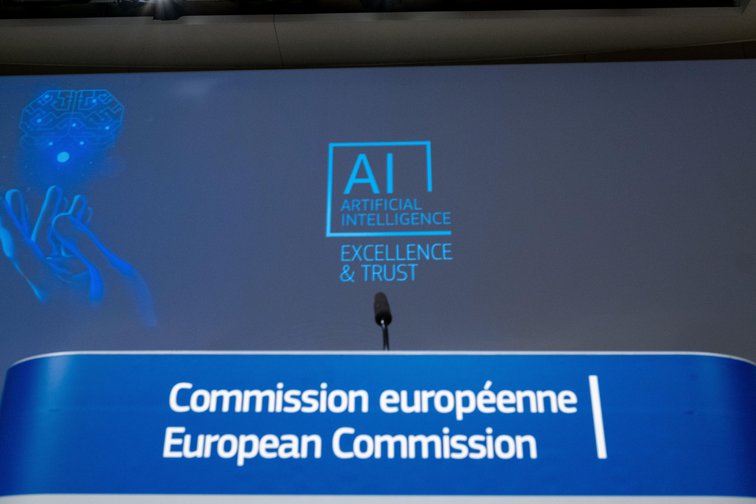
In April this year, the European Commission proposed the Artificial Intelligence Act Martin Bertrand / Alamy Stock Photo. All rights reserved

In April this year, the European Commission proposed the Artificial Intelligence Act, which aims to regulate the use of AI-driven products, services and systems within the EU. But the market-driven draft legislation, aimed at creating and developing a competitive European AI sector, failed to meet the expectations of civil society, which had been hoping that the act would prioritise the protection of people.
The EU Council presidency also criticised the text, pitching substantial changes to the proposal and suggesting, in particular, further restrictions on the possible use of a ‘social credit system’ and facial recognition technology. Critical negotiations are ongoing, but there is no guarantee that they will result in the draft law becoming more protective of individuals.
Employment and workers’ rights are particular areas of concern in the context of the AI Act, and measures must be taken to ensure that workers are protected.
AI in the workplace
When they work, AI systems do what we ask them to do: achieve an objective. But, it is easy to give an AI system the wrong problem to solve, or for it to produce solutions that are useless, wrong or biased. What’s not so easy is identifying issues like this before something goes wrong. As AI systems are being entrusted with increasing ‘authority’ in the workplace and in hiring processes, for example screening resumes and estimating the ‘risk level’ of workers, we need to ask whether developers can build AI systems that are protective of workers’ rights when the system’s objectives have nothing to do with these rights.
How can we set limits on a system that may have a negative impact on workers and their rights? Given these questions and the particular risks that AI raises in the context of employment, the European Commission should produce an additional ad hoc legislative proposal dedicated to protecting workers’ rights when they are exposed to, interact with or work with AI systems.
With some amendments, the final AI Act could – and should – become a less permissive tool of market regulation, compared to its current version, one that addresses issues related to the impact of AI on workers, who are particularly at risk given their subordinate position in the employment relationship.
As it stands, the proposed AI Act does not regulate AI. What it does is establish rules concerning the placing of “AI systems” on the market and putting them into service and use.
It is clear from the draft that the primary objective of the European Commission is to foster the development and uptake of AI for economic growth. Meanwhile, protecting the public interest, in particular the health, safety and fundamental rights and freedoms of individuals, is only a side objective, and the draft includes only a limited number of concrete provisions to achieve these objectives.
Issues the draft must address
Updating and modernising the understanding of work-related risks to include data-driven or AI-related risks. This would involve conducting an extensive anticipatory exercise involving both employers and workers. The new way of thinking about workplace risks should be broad and go beyond occupational health and safety. It should include the risks to privacy, data protection and fundamental rights, and the possible abuses of managerial power stemming from the employment relationship.
The ‘transparency paradox’ at work must be addressed. Transparency does not work in the workplace as it is a unilateral requirement that does not provide workers with actionable rights. As AI applications involve processing personal data, including workers’ data, reaffirming the relevance of GDPR rights and making them explicit in the context of employment is essential. AI systems use workers’ data for predictive analysis, performance evaluation or task distribution, and workers must be able to fully exercise their rights under GDPR with their employers.
In line with GDPR, Workers must more easily be able to exercise their right to explanation (GDPR Art 22) of how their data is being used. If workers don’t understand how their data is being used to manage and evaluate them, they can’t take action to protect their rights.
Equally important is that workers can exercise their right to be consulted. This can imply an obligation for employers to consult workers before AI systems are implemented and to provide a mechanism to monitor the outcomes.
From a labour perspective, trying to fit protective provisions into the AI Act proposal may turn out to be like trying to push square pegs into round holes
Affirming the ‘human-in-command’ principle as a component of work organisation, and preserving worker autonomy in human-machine interactions. In the workplace, humans and machines act together. Managers, IT support team or external experts cannot be the only humans actively interacting and intervening with the AI systems. When joint (human- machine) problem solving takes place, employers should ensure that the AI systems they deploy always require worker interaction, for example by using feedback loops or validation systems, and by incorporating workers knowledge and understanding of their own roles and tasks within their jobs.
A total ban of algorithmic worker surveillance. AI systems can bring worker monitoring to a new level, which can be defined as ‘algorithmic worker surveillance’. Advanced analytics can be used to measure biology, behaviours, concentration and emotions. One can compare this to switching from radar, which scans the surface of the sea, to sonar, which builds a 3D image of everything under the surface. Such surveillance is extremely intrusive, as it does not passively scan but ‘scrapes’ the personal lives of workers, actively building an image and then making judgements and decisions about individuals. It must be banned.
From a labour perspective, trying to fit protective provisions into the AI Act proposal may turn out to be like trying to push square pegs into round holes. The time is right to ask fundamental questions on how best to address the governance of AI, including the necessary ability to assess risks before implementing AI systems and those risks materialise into reality.
The AI Act was designed by the European Commission to ensure the development of a competitive and ‘deregulated’ European AI market. But a more balanced approach is needed and the European Parliament and Council should listen to the many voices asking for a regulatory framework that also protects citizens’ and workers’ rights.
USA
‘Weaponization of medicine’: police use of ketamine draws scrutiny after Elijah McClain’s death
The sedative is used more often on Black people – and justified after the fact with questionable claims of ‘excited delirium’

String players perform during a vigil for Elijah McClain in New York City. McClain played the violin. Photograph: Byron Smith/Getty Images
Josiah Hesse
Fri 17 Dec 2021
In the summer of 2019, 23-year-old Elijah McClain was stopped by the Aurora, Colorado, police while walking home, after someone called 911 saying he looked suspicious.
The incident quickly turned violent, with three police officers piling on the 140lbMcClain, twice putting him in a chokehold that has since been banned. After vomiting, coming in and out of consciousness and pleading for breath, paramedics arrived and injected McClain with an excessive dose of ketamine, a powerful sedative.
He immediately went limp and went into cardiac arrest on the way to the hospital, dying a few days later.
The three police officers and two paramedics have since been charged with criminally negligent homicide, and the family of McClain – who was Black – was recently awarded $15m in a civil lawsuit against the city of Aurora, the second largest of its kind, just behind the one awarded to George Floyd’s family.
McClain’s death magnified the American reckoning with racism and police brutality but it has also sparked a national debate about the use of ketamine – a medical anesthetic, popular club drug, and psychotherapy tool – in law enforcement situations, leading to its ban in the state of Colorado, and possibly across the nation.
“What we’re talking about is the weaponization of medicine,” says Mari Newman, the lawyer representing McClain’s family. “It might as well be a taser or a gun.”
Newman says that McClain was exhibiting none of the signs of “excited delirium syndrome” – a controversial diagnosis that legally warrants a ketamine injection – and that police officers erroneously employed “code words like ‘he had superhuman strength’” that she says were an attempt to influence paramedics to give the injection (and justify their own use of excessive force).
Police are not legally allowed to administer ketamine. Paramedics can, but only if a patient is exhibiting symptoms of “excited delirium”. The controversy surrounding this diagnosis – characterized by aggressive behavior, superhuman strength and hyperthermia – comes in part from its emergence during the war on drugs in the 1980s, and is applied disproportionately in the post-mortem of Black men killed by police. The condition is not recognized by the Diagnostic Statistical Manual of Mental Health Disorders, or the American Medical Association.
A report by public radio station KUNC revealed that in the past 2.5 years, Colorado medics injected 902 people for excited delirium, leading to serious complications in 17% of cases. The American Society of Anesthesiologists recently stated it “firmly opposes the use of ketamine or any other sedative/hypnotic agent to chemically incapacitate someone for a law enforcement purpose and not for a legitimate medical reason”.
A Minnesota medic filed a whistleblower lawsuit last year claiming police had pressured him to inject someone with ketamine during an arrest, adding that such acts are not uncommon (in Minneapolis, ketamine use grew from an average of four law enforcement incidents a year, to 62, from 2015 to 2017).
After the death of McClain – and a similar incident involving Aurora police – the state of Colorado passed legislation last June banning the use of ketamine for excited delirium, and clarifying that police should never influence medics to use it. “EMS is responsible for patient care, not law enforcement,” Governor Jared Polis said in a signing statement. “Ketamine should not be used for law enforcement purposes.”
A similar federal bill was introduced shortly after, and is being considered by Congress.
Emergency Medical Services Association of Colorado president, Scott Sholes, says that, when used according to protocol, ketamine is the safest alternative to violence or other sedatives available to paramedics, and removing it from their toolbox puts them at a serious loss.
“I can tell you horror stories about physically restraining people for hours, back in the day,” says Sholes. “For the first ten years of my career it was strapping people to back-boards, sometimes flipping the board over and sitting on it in order to control people, and eventually we got some medications we could use.”
Starting in the early 1990s, Shole says, medics could use antipsychotics like Haldol, and later benzodiazepines like Valium or opioids like fentanyl, to subdue those who pose a threat to themselves or others. But these drugs could often take 30 minutes to take effect, and sometimes delivered the opposite effect intended.
“In comparison, ketamine takes three to four minutes, is easy to dose, has the safest profile, and has remarkable success with sedation,” Sholes says. “With everything we’ve seen in the media on ketamine, no one is looking at the data.”
Sholes points to a study released last summer revealing that, of the 11,291 instances of patients being injected with ketamine by paramedics, “patient mortality was rare. Ketamine could not be ruled out as a contributing factor in 8 deaths, representing 0.07% of those who received ketamine.”
Sholes stresses a kind of church-and-state separation between medics and law enforcement, and that paramedics should never be collaborating with police in the execution of their duties. However, he admits, there have been instances where this line has been blurred, violating EMS protocol.
And in the case of Elijah McClain, he says that Aurora paramedics failed to follow basic practices in the administration of ketamine.
“I’ve been a paramedic for 40 years, and that video [of McClain’s death], if you think it’s bad from a layman perspective, it’s astonishing to me,” says Sholes. “That’s not how ketamine is commonly used … In that video, I see paramedics who did not assess the patient. By the time they injected him, he wasn’t moving, certainly wasn’t fighting. He was given way more [ketamine] than protocol called for. ”
First approved by the FDA for use as an anesthetic in 1970, ketamine has been a popular medical tool for pain relief and sedation in humans and animals for decades.
In the 80s and 90s, illicit use of ketamine (or “special K”) was popularized by the rave scene of New York City’s club kids, who took it for its euphoric, hallucinogenic properties. In recent years, it has shown remarkably promising results in the treatment of mental health disorders, spawning an industry of “ketamine clinics” around the US.
“Ketamine’s effects operate on a spectrum,” says Desmond Wallington, a psychologist and Colorado mental health director for Klarisana, a ketamine clinic. “On the low-dose end it’s a psycholitic; so time, space and reality briefly dissolve around you. And then there’s a psychedelic experience, where those effects will last for an hour or so, and on the far end there’s an anesthetic [unconscious] experience. We operate in the first two realms.”
Wallington says he “cringes” at the idea of ketamine being used in a law enforcement context, particularly because of its growing association with police brutality against young Black men.
“You don’t want to give ketamine to someone with schizophrenia or schizoaffective disorder – you could send them into a delusional headspace and leave them worse than you found them,” he says. “If they’re already on a stimulant, you’re putting them at risk for a stroke.”
McClain’s family attorney, Mari Newman, says that she believes ketamine injections are being used by law enforcement simply to silence an unruly suspect.
“If someone’s disagreeing with an officer, what better way to shut them up than to knock them right out?” she says.

















